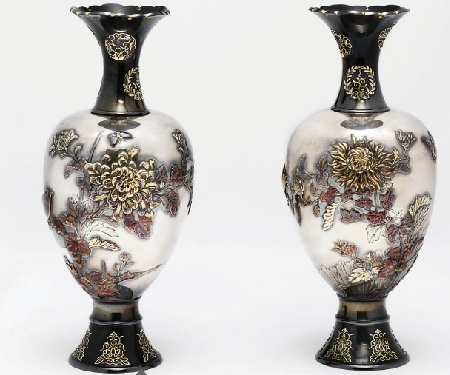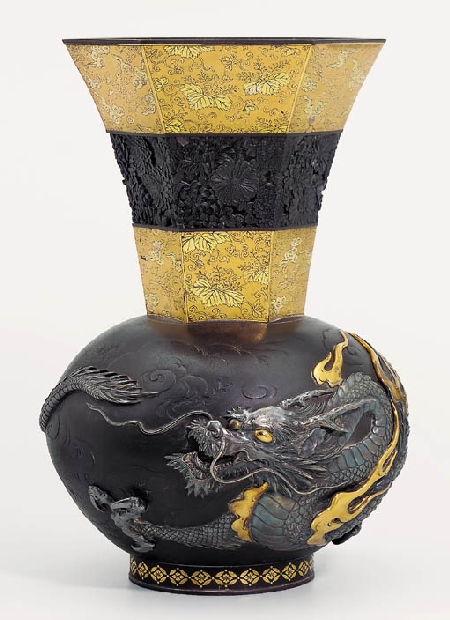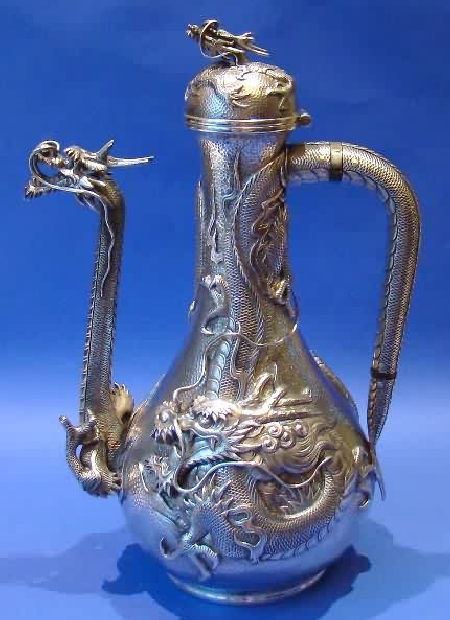Ozeki Yahei 大関弥兵衛
Ozeki Yahei 大関弥兵衛
 A Pair of Ozeki Studio Vases. Signed Inshi Motonobu koku and sealed Yamada, sealed on base Ozeki sei, circa 1880. Each chased, hammered, engraved and inlaid in various patinated metals including gold and copper on a silver body, the foot and neck in shakudo, depicting chrysanthemums and brushwood fences, the foot with foliate lappets, the neck with floral roundels, the gilt rim pierced in the form of a snowflake. High:23cm. GBP 32,450 auctioned at Christie's on 13 May 2009.Ozeki Yahei 大関弥兵衛 was especially wellknown in the West as a broker for the highest quality metalwork objects. Ozeki commissioned works from such leading metalworkers as;
A Pair of Ozeki Studio Vases. Signed Inshi Motonobu koku and sealed Yamada, sealed on base Ozeki sei, circa 1880. Each chased, hammered, engraved and inlaid in various patinated metals including gold and copper on a silver body, the foot and neck in shakudo, depicting chrysanthemums and brushwood fences, the foot with foliate lappets, the neck with floral roundels, the gilt rim pierced in the form of a snowflake. High:23cm. GBP 32,450 auctioned at Christie's on 13 May 2009.Ozeki Yahei 大関弥兵衛 was especially wellknown in the West as a broker for the highest quality metalwork objects. Ozeki commissioned works from such leading metalworkers as;
Unno Moritoshi 海野盛寿,
Yamada Motonobu 山田元信,
Kaneyasu Masatoshi 兼康正寿,
Ikeda Minkoku 池田民国
- all of which appeared in exhibitions under the brand name Ozeki 大関.
The marvelous inlay work on Ozeki pieces is astonishing, but they seem over elaborate to Japanese tastes. On the other hand, this is an indication of Ozeki's success as a businessman, for he had a firm grasp of Western tastes. Ozeki remained in business throughout the Meiji period and into the subsequent Taisho era (1912-1926).
Musashiya Company by Ozeki Yahei 大関弥兵衛
 Iron Flower Vase signed Masatoshi and Musashiya, Mid-Meiji Period (Circa 1880-90)
With splayed hexagonal neck and flattened spherical body rising from a vertical foot-ring, the foot-ring decorated in gold overlay with formal floral ornament, the body with a dragon applied in bold high relief of gold and silver, with clouds and waves cast in the iron, the neck with two bands of delicate overlay of paulownia leaves and ho-o birds in two different textures of gold, separated by a cast and chiselled partially openwork band of chrysanthemums, the top edge also finished in gold overlay, signed on the body on an applied gold plaque in the shape of a hanging lantern Ittosai Masatoshi kore o tsukuru [Ittosai Masatoshi made this] and with a gold wire mark on the base Musashiya and a gold pot-seal Ozeki sei [made by Ozeki] 11¾in. (29.8cm.) high. Sold at £47,000 at Christie's on 20 June 2001.The Musashiya company, operated by Ozeki Yahei 大関弥兵衛 and his son Sadajiro, were perhaps the most successful of the concerns selling high-quality decorative art during the Meiji era.
Iron Flower Vase signed Masatoshi and Musashiya, Mid-Meiji Period (Circa 1880-90)
With splayed hexagonal neck and flattened spherical body rising from a vertical foot-ring, the foot-ring decorated in gold overlay with formal floral ornament, the body with a dragon applied in bold high relief of gold and silver, with clouds and waves cast in the iron, the neck with two bands of delicate overlay of paulownia leaves and ho-o birds in two different textures of gold, separated by a cast and chiselled partially openwork band of chrysanthemums, the top edge also finished in gold overlay, signed on the body on an applied gold plaque in the shape of a hanging lantern Ittosai Masatoshi kore o tsukuru [Ittosai Masatoshi made this] and with a gold wire mark on the base Musashiya and a gold pot-seal Ozeki sei [made by Ozeki] 11¾in. (29.8cm.) high. Sold at £47,000 at Christie's on 20 June 2001.The Musashiya company, operated by Ozeki Yahei 大関弥兵衛 and his son Sadajiro, were perhaps the most successful of the concerns selling high-quality decorative art during the Meiji era.
Originally a dealer in pipes, Ozeki Yahei set up the Yokohama branch at 66 Main Street, probably under the management of his son Ozeki Sadajiro, soon after the port was opened in 1859.
In 1877, both father and son exhibited commissioned pieces under their separate names in the first Naikoku Kangyo Hakurankai [National Industrial Exposition].
By 1880, the company is recorded as employing twenty-four people and dealing in enamels, bronzes, ivory, crystal, carvings, pins, fans, hardstones, tortoiseshell, lacquer, and a variety of ceramics.
Joe Earle, Splendors of Meiji: Treasures of Imperial Japan, Masterpieces from the Khalili Collection (St. Petersburg, Florida, Broughton International Publications, 1999), p. 94
For other examples of collaborations between Musashiya and Kaneyasu Masatoshi, see Oliver Impey and Malcolm Fairley (eds.), Meiji no Takara: Treasures of Imperial Japan (The Nasser D.Khalili Collection of Japanese Art, London, Kibo Foundation, 1995), volume 2, part 1 (Metalwork), cat. nos. 52 and 53.
 Top
Top Site Map
Site Map References
References About Me
About Me
